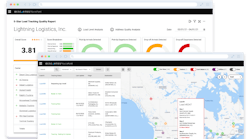More recently, the term “the last mile” has referred to how telecommunications and cable companies get information to people in the last mile to their homes. While attending a webinar put on by Telogis this week, they identified the last mile as one of five important trends, but gave it a slightly different meaning. This is the new term for discussing the final stage of delivery of product to a customer.
Think about all the recent announcements and trials for getting packages to customers who have ordered over the internet. Amazon is contracting with the US Post Office to make deliveries on Sundays. (What happened to the Post Office wanting to deliver mail only Monday through Friday? Now they add a 7th day instead of eliminating the 6th day?) Others want to use drones to finish delivery.
We have people experimenting with pickups, much like what I already do at the UPS Store, where my official address is located. The idea is that you pick up your packages at the grocery store when you stop for milk. That’s not such a new idea, since people have been using post office boxes for years and making a daily trek to pick up their mail and packages. That got me to thinking. When I stop at the gas station, I sometimes take advantage of the convenience store to pick up some small essential. The idea is as old as it gets. If you’re selling something to a customer, what else can you sell to that same customer?
Unfortunately, the pricing at the convenience store connected to the gas station is outrageous, and the selection is inadequate. So, the grocery stores have done the inverse and offer gas near where you buy your groceries. I thought of another place where people queue up, twice a day, to drop off and pick up something valuable—your local elementary school. Some schools even make it pretty efficient with people driving in single file in a specific direction. It’s almost like a subway car arriving and people pouring into and out of them.
Drive-ins used to be a place where you went and parked your car to watch a movie for few hours and eat junk food. There are very few of that type left. Instead, drive-through has replaced it in so many places. We don’t have time to stop for anything (except stopping in the long line of cars waiting for that quick-to-pick-up latte).
This week I was shocked to learn how big the same day and next day courier business is within a city. We’ve just got to have it now, and I mean now. I’m the type that plans my trips outside the house to achieve errands in the least amount of travel and time. I’m like a UPS driver with a route that has been determined in advance and eliminates all those time consuming and unsafe left-hand turns. Others don’t think that way; they like the experience more. This even translates to shopping malls now. Someone came up with an application for someone like me, that guides me to each of the right stores in a mall based on the type of product I’m looking for. (I thought I could already figure that one out myself without an app.) I don’t think the people who go to a mall to “hang out” and enjoy the shopping experience will be interested in that app.
It’s pretty obvious to me, when I think about it, that home delivery is going to be different 10-15 years from now. With congestion and more internet based shopping every day, I cannot imagine multiple delivery services making multiple runs in my neighborhood every day. I have trucks coming every day delivering packages to my door. And I’ve got trucks coming every week to pick up my recycling, garbage and yard debris (3 separate trucks). There HAS to be a better way.


